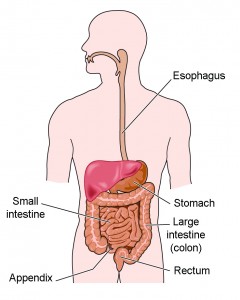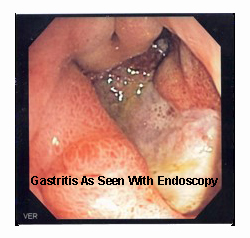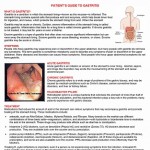SEPA Patient Focus – Gastrits
PATIENT’S GUIDE TO GASTRITIS
WHAT IS GASTRITIS?
Gastritis is a condition in which the stomach lining—known as the mucosa—is inflamed. The stomach lining contains special cells that produce acid and enzymes, which help break down food for digestion, and mucus, which  protects the stomach lining from acid. When the stomach
protects the stomach lining from acid. When the stomach
Gastritis may be acute or chronic. Sudden, severe inflammation of the stomach lining is called acute gastritis. Inflammation that lasts for a long time is called chronic gastritis. If chronic gastritis is not treated, it may last for years or even a lifetime.
Erosive gastritis is a type of gastritis that often does not cause significant inflammation but can wear away the stomach lining. Erosive gastritis can cause bleeding, erosions, or ulcers. Erosive gastritis may be acute or chronic.
SYMPTOMS
People who have gastritis may experience pain or discomfort in the upper abdomen, but many people with gastritis do not have any symptoms. The term gastritis is sometimes mistakenly used to describe any symptoms of pain or discomfort in the upper abdomen. Many diseases and disorders can cause these symptoms. Most people who have upper abdominal symptoms do not have gastritis.
Acute gastritis is an irritation or erosion of the stomach’s inner lining. Alcohol, aspirin, and drugs like ibuprofen may erode the mucosal lining of the stomach and cause abdominal pain.
CHRONIC GASTRITIS
Chronic gastritis refers to a wide range of problems of the gastric tissues, and may be caused by medical conditions such as Crohn’s disease, certain connective tissue disorders, and liver or kidney failure.
HELICOBACTER PYLORI
Helicobacter pylori is a unique bacteria that colonizes the stomach of more than half of the world’s population, and this bacterial infection plays a key role in the problems many patients experience with gastric disease.
TREATMENT
Medications that reduce the amount of acid in the stomach can relieve symptoms that may accompany gastritis and promote healing of the stomach lining. These medications include:
- antacids, such as Alka-Seltzer, Maalox, Mylanta,Rolaids, and Rio-pan. Many brands on the market use different combinations of three basic salts—magnesium, calcium, and aluminum—with hydroxide or bicarbonate ions to neutralize the acid in the stomach. These drugs may produce side effects such as diarrhea or constipation.
- histamine 2 (H2) blockers, such as famotidine (Pepcid AC) and ranitidine (Zantac 75). H2 blockers decrease acid production. They are available both over the counter and by prescription.
- proton pump inhibitors (PPIs), such as omeprazole (Prilosec, Zegerid), lansoprazole (Prevacid), pantoprazole (Protonix), rabeprazole (Aciphex), esomeprazole (Nexium), and dexlansoprazole (Kapidex). All of these drugs are available by prescription, and some are also available over the counter. PPIs decrease acid production more effectively than H2 blockers.
Treating H. pylori infections is important, even if a person is not experiencing symptoms from the infection. Untreated H. pylori gastritis may lead to cancer or the development of ulcers in the stomach or small intestine. The most common treatment is a triple therapy that combines a PPI and two antibiotics—usually amoxicillin and clarithromycin—to kill the bacteria. Treatment may also include bismuth subsalicylate (Pepto-Bismol) to help kill bacteria.
Click on image below to download your own printable copy of this handout




